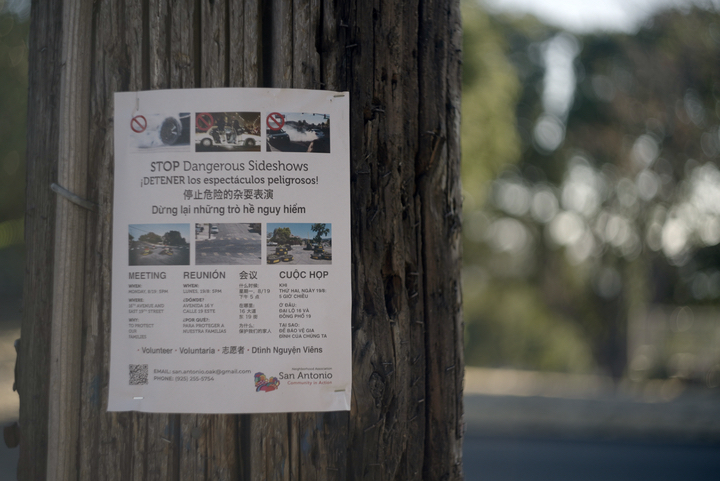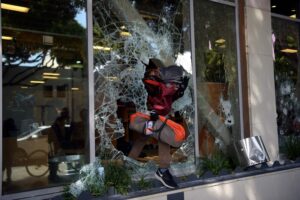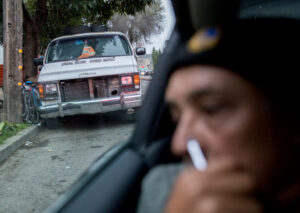Juan Salcedo was fed up with the endless stunt driving outside his front door. Day and night, young men took over the intersection in front of his house and did doughnuts, sometimes for hours on end. At around five in the morning, Salcedo, a bearded, middle-aged homeowner, walked outside and confronted the drivers, asking them to cut it out. One of them pulled a gun on him and said, “This is Oakland. Go back inside.”
Even more than its neighbour San Francisco, Oakland is known for its extraordinarily high levels of crime. The city’s police force is understaffed by hundreds of officers. Only 35 are on patrol in the city of nearly half a million at any given time, and they’re limited by rules that prevent them from, for instance, pursuing drivers fleeing crime scenes. The situation is so extreme that California’s governor, Gavin Newsom, has deployed state highway patrol officers to do city police work.
But the crime that seems hardest to stop is also the most inane: sideshows. In the Eighties, the earliest sideshows were largely benign: young men would cruise through the neighbourhood in swanky cars in a kind of impromptu parade, like something out of the film American Graffiti. “I used to go to sideshows as an 18-year-old,” former Oakland police chief LeRonne Armstrong tells me. “It was just guys from the community showing off nice, restored cars.”
In time, drivers started performing tricks in the intersections. This was not unusual for California low-rider culture — but since then, these sideshows have evolved into something more threatening. “Now it’s a speed exhibition. It’s lawlessness,” Armstrong says.
Today’s sideshows are typically organised through text chat and WhatsApp groups. But if you’re not in the loop, they appear spontaneous: dozens of cars will suddenly appear at an intersection, often in the middle of the night, surrounded by hundreds of boisterous onlookers. Cars do doughnuts and burnouts with passengers hanging out of the windows, while the crowds film them to post on YouTube and Instagram. People launch fireworks, fire their guns into the air and torch abandoned vehicles. If the cops show up, the crowds just jeer at them.
Sometimes bystanders are hit by drifting cars. Last weekend, a swaggering red Mustang crashed into the crowd, running over a woman. Residents living near the crime scene told me that sideshows have been a problem for years. “It’s every other Friday or Saturday night,” Joel Everett, a 63-year-old church member, tells me. People park on his residential street to join the crowd of spectators, leaving trash, bottles and cans everywhere, and pulling in and out of his driveway to make three-point turns. Everett worries about his car getting stolen or broken into. “You can’t sleep. There’s gunfire,” he says.
Another neighbour, Marcos, who declined to give me his last name, is a 65-year-old truck driver who works at night. One early morning, returning home from work, he had to sit in his car for an hour and a half waiting for a sideshow to disperse just to drive the last block to his house.
In the past few years, Oakland’s sideshows have become more diffuse: according to the city, several hundred intersections are regularly used for sideshows. Spiralling skid marks stain streets all over town. And nowadays, you’re as likely to hear the screeching of tires at 10am as you are at midnight. A single car will do a spontaneous intersection takeover in broad daylight, without a pre-warned crowd gathered for the spectacle. Affluent neighbourhoods aren’t safe, either: one of the most popular intersections is on Skyline Boulevard, on the ridge of the Oakland Hills, alongside a regional park used by hikers, joggers and equestrians. Sideshows have also spread to other cities in the Bay Area, including San Francisco.
Even though sideshows began in Oakland, they now tend to be organised and attended by a marauding group of participants from all over northern California. “I would say 70% are from out of town,” Armstrong says. “It’s a group that’s causing havoc throughout the East Bay.”
With their drunk and hopped-up crowds, sideshows are often preludes to other crimes. Last month, five people were shot during one in East Oakland. In July, a sideshow mob ransacked a convenient store near the airport, racking up $100,000 in damages. In June, 15 people were shot in a gunfight following a sideshow.
With no faith in the city authorities or the police, tormented residents have taken matters into their own hands. Last month, Salcedo and his neighbours put up impromptu barriers in the worst-hit intersections in Oakland’s San Antonio district to discourage the mayhem. They dragged tires into the road, filled them with rocks and dirt, and painted them in bright colours. They installed speed bumps and Botts’ Dots pavement markers purchased on Amazon. And they did all this without the city’s permission or knowledge.
Users on one Oakland subreddit applauded the intervention. “I’m tempted to do something similar,” wrote one user. “The city has failed us so might as well take matters into your own hands.”
For a while, the San Antonio neighbourhood’s guerrilla installations worked. But a driver speeding in a stolen Lexus hit one of the tires and flipped it over. City workers came in one morning soon after and removed the tires, leaving some of the smaller, less hazardous impediments in place.
After that, residents lost patience with the city. At an outdoor meeting with a council member, a city engineer lectured the neighbours about Oakland’s liability for their handiwork. He told them that the impediments were a fire code violation as they blocked the egress of fire trucks, and that the risks they posed to drivers was “non-negotiable”.

“Your liability is more important than my kid being hit by a car?” one neighbour asked. The residents complained of cars running up on sidewalks where kids play; one of the worst intersections is between a park and a middle school. A Brazilian man named Odelson Souza said his two-year-old was once nearly run over. From the neighbours’ perspective, the city is more worried about the hypothetical safety risks posed by their DIY obstacle course than the real risks posed by daily sideshows.
The city is currently testing new hardscape solutions such as bollards and traffic circles, but at the tectonic rate of about one intersection a month. The police, meanwhile, are powerless to shut down sideshows when they involve hundreds of people, many of them armed — though Armstrong told me that they have had some success embedding undercover officers in the crowds, taking pictures of cars and licence plates, and impounding the vehicles in the days that follow. Last year, the county made it illegal to attend a sideshow as a spectator, though that law is being challenged in federal court.
Besides being annoying, dangerous and occasionally deadly, sideshows have come to embody Oakland’s surrender to brazen criminality. Not far from where Salcedo and his neighbours put up their road blocks, there is open sex trafficking, day and night. Pimps and prostitutes operate outside schools. Meanwhile, the streets alongside Oakland’s 880 freeway are filled with tarp and tent encampments, and decaying RVs clog miles of sidewalk on either side of the Oakland Coliseum, which the city’s last professional sports team will soon abandon.
The defiant screech of the sideshow is a constant reminder to Oakland residents that when it comes to public safety, they’re on their own. But to the residents of San Antonio, it’s even worse than that: they’ve learned that even when they improvise their own fixes, the city will remove them. “Right now, they protect the criminals,” Salcedo told his neighbours at their meeting. “They need to protect us.”
Disclaimer
Some of the posts we share are controversial and we do not necessarily agree with them in the whole extend. Sometimes we agree with the content or part of it but we do not agree with the narration or language. Nevertheless we find them somehow interesting, valuable and/or informative or we share them, because we strongly believe in freedom of speech, free press and journalism. We strongly encourage you to have a critical approach to all the content, do your own research and analysis to build your own opinion.
We would be glad to have your feedback.
Source: UnHerd Read the original article here: https://unherd.com/



